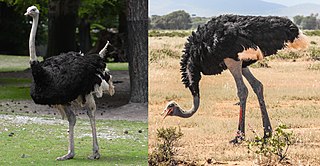
Ostriches are large flightless birds. They are the heaviest and largest living birds, with adult common ostriches weighing anywhere between 140-320 lbs and laying the largest eggs of any living land animal. With the ability to run at 70 km/h (43.5 mph), they are the fastest birds on land. They are farmed worldwide, with significant industries in the Philippines and in Namibia. Ostrich leather is a lucrative commodity, and the large feathers are used as plumes for the decoration of ceremonial headgear. Ostrich eggs have been used by humans for millennia.

Pancratium is a genus of African and Eurasian perennial, herbaceous and bulbous plants in the Amaryllis family, subfamily Amaryllidoideae

Mocis frugalis, the sugarcane looper, is a moth of the family Erebidae. The species was first described by Johan Christian Fabricius in 1775. It is found in several parts of the world, including India, Sri Lanka, West African countries and other Oriental regions. The adult is a fruit piercer and a major pest of crops.

Mocis is a genus of moths in the family Erebidae. The genus was erected by Jacob Hübner in 1823.

The Erebinae are a subfamily of moths in the family Erebidae erected by William Elford Leach in 1815. Erebine moths are found on all continents except Antarctica, but reach their greatest diversity in the tropics. While the exact number of species belonging to the Erebinae is not known, the subfamily is estimated to include around 10,000 species. Some well-known Erebinae include underwing moths (Catocala) and witch moths (Thermesiini). Many of the species in the subfamily have medium to large wingspans, up to nearly 30 cm in the white witch moth, which has the widest wingspan of all Lepidoptera. Erebine caterpillars feed on a broad range of plants; many species feed on grasses and legumes, and a few are pests of castor bean, sugarcane, rice, as well as pistachios and blackberries.

Mocis mayeri is a species of moth in the family Erebidae first described by Jean Baptiste Boisduval in 1833. It has a wide range in Africa, which includes Cameroon, Cape Verde, the Comoros, the Democratic Republic of the Congo, Eritrea, Ghana, Kenya, Réunion, Madagascar, Malawi, Mauritius, Mozambique, Nigeria, Senegal, the Seychelles, Sierra Leone, South Africa, Sudan, Tanzania, the Gambia, Uganda, Zambia and Zimbabwe. It is also found in Saudi Arabia and Yemen.
Eutelia catephioides is a moth of the family Noctuidae. It is found in South Africa, Ethiopia and Saudi Arabia.






